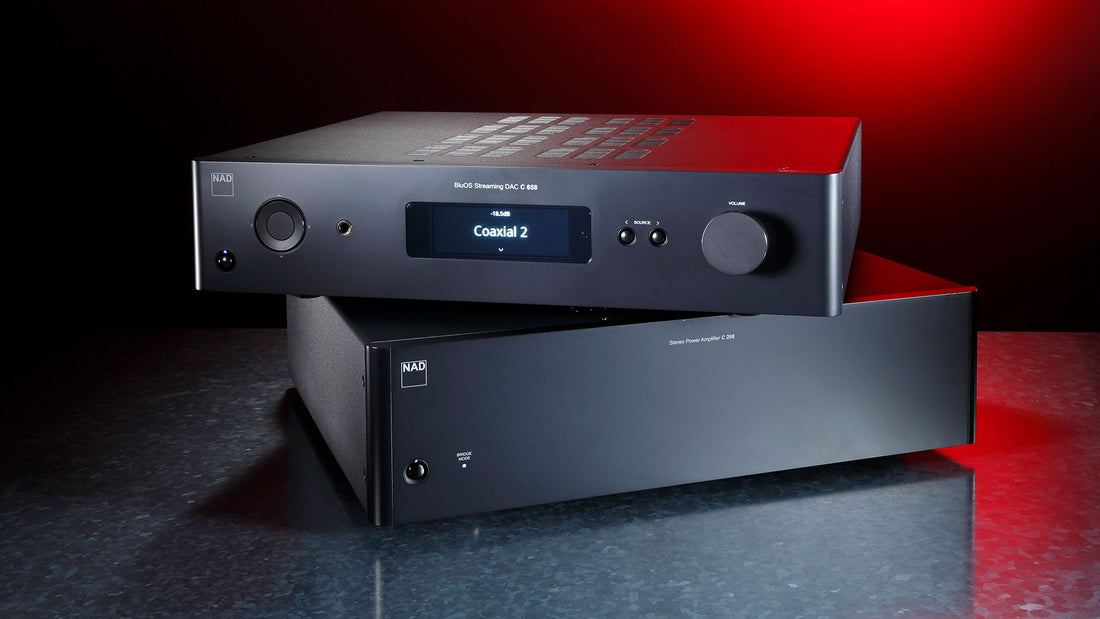
New NAD amp brings the power
NAD is a brand synonymous with high fidelity audio and the starting point for many of us many years ago. The legendary 3020 stereo amplifiers of the day were famous for value, performance and longevity.
NAD is one of those iconic names that almost every audiophile has a fond association with, probably because it has always been about above average performance. In some ways it set a benchmark against which others were measured, both in terms of value for money and by setting the standard for the beginning point for hi-fi hobbyist enthusiasts.
“Giant killers'”was an expression I recall being used more than once with NADs in differing guises over the years. I may even have done so myself!
Now we have a new iteration of power from the powerhouse itself. On test here we have the C 298 power amplifier and it is a bit of a beast, if this is somewhat hidden by the entirely unassuming front fascia of the black front face. There is but a single button featured, and a single discrete LED to let you know it’s status (bridge mode lettering being a hint).
The subtle traditional NAD logo top left and centered top “Stereo power amplifier C 298” is sublimely discreet understatement. Once you plug it in, there is nothing understated about what comes out of those cables into your speakers. Further hints from the rear are the quality input and output gear, with balanced XLR inputs speaking visually to the C298s aspirations of high end.
The power stats are impressive. Bumping from 185W a channel in standard stereo amplification mode to 620W when you add a second and set them into bridge mode (such that each amp drives a single channel) tells you that this is no ordinary run of the mill unit. Those are figures that can make very much more expensive units blush and sink away into the shadows.
Quite aside from an outright power arm wrestle, it gives user a useful upgrade path, at least for those seeking the enlightenment that only massive power can provide. Hence, your budgetary pathway need not be overburdened from the outset, but rather letting you add to the listening experience as your wallet allows.
The big issue for me is that, even in stereo mode, the C 298 is already so good that perhaps you might never need to go to two of them. Although the thought of all that power does do something to my neural pathways that borders on frazzle.

For now, I had the C 298 run in on my Martin Logan ESLs, which are not the easiest things in the world to drive. Being a power amp, I hooked it up to my reference Node directly and used that for my pre amp volume control, which was how the system remained for the test period.
During run-in, the amp was not driven particularly hard. But, on occasion when I was passing by, I did take a listen to some particularly juicy tracks that Tidal threw my way randomly. The promise of what was to come was writ strong and, after a week, I was ensconced in my listening position all ears attentive.
The C 298 does not disappoint. Immediately apparent was the sense of reserves of power that felt seemingly infinite. The amp grabbed those ESLs by the virtual scruff of the neck and held them in a vice grip from there on out. There’s no negotiation or ambiguity in the performance with the power amp simply lifting the speaker’s performance in leaps and bounds.
Even for the already broad and open soundstage that I enjoy from them, the speakers were opened up a degree further, but with a sense of willingness to exploit every square centimeter of moving membrane to maximum effect.
The old adage of a veil being lifted might be a stretch in describing the ancillary added detail that I was hearing, but it is not far off being an appropriate analogy to the extra levels of performance that the C 298 added to my system. There was a notable improvement across the board from my trusty 110W RXV-767 to the extent that, as I write this, I’m not entirely sure how I am going to be able to give the amp back.

The slam and speed improvements were the most noticeable, with a tighter bass and stunningly low noise floor combining to render even complex recordings as simple auditory delights to one’s ear, a true test of any good setup.
It would be hard to accuse the NAD of adding any bias to the tonal range either. If anything, the iron fisted control that the amp renders, in particular to the bass, means that the extra depth I was getting is simply due to the drivers being held more tightly. There is little added and, perhaps more importantly, less being taken away and lost in translation. Not once did the amp ever feel as if it was being stretched, but rather, that the delivery was measured exactly as it should be.
There is a sense of timing that I was sure wasn’t there before. The longer I listened, the more an overall sense of neutrality built. There was less noise reflected in a more detailed soundstage that was giving me a more precise sense of positioning. But the NAD still manages to be transient when it needs to be, with reverbs almost tangible in their execution.
In fact, this is often something that I listen for and it is not easy to accomplish this in any meaningful way when one considers room dynamics that come into play. There needs to be excellent differentiation between quiet moments and the loud ones, with speed being important to be able to pull off effectively.
I haven’t even reverted to talking about musicality, which I often tend to do, because hi-fi is about how a system makes you feel about the music you’re listening to. In the case of the NAD C298, I’m not going to do it either, because you can take it as read that it’s already baked into the cake.
The sense of power that the unit delivers, the control it executes and the ease with which it dealt with everything I threw at it convinces me that we have a remarkable and special amplifier here and I could not fault it.
This is a NAD in every sense of the word, but with one tiny almost insignificant difference: Whereas NADs of old may have been fondly referred to as giant killers, this is no longer true. The C298 is the giant, and you will not kill it.
All credit to William Kelly and gadget.co.za
Original article here:
https://gadget.co.za/nadampc298/

